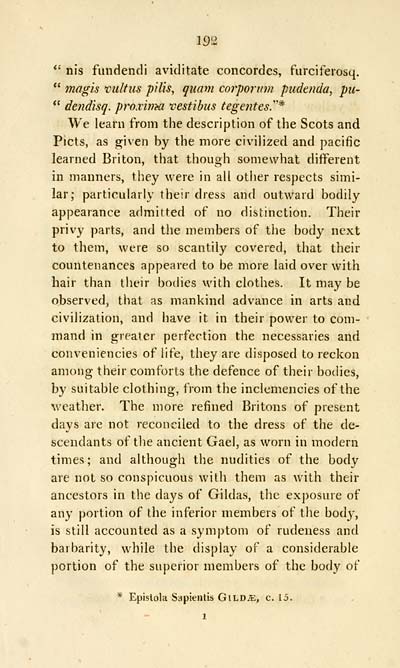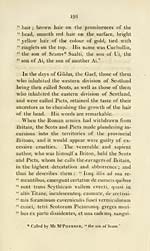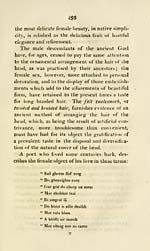Download files
Complete book:
Individual page:
Thumbnail gallery: Grid view | List view

192
*' nis fimdendi aviditate Concordes, furciferosq.
" magis vultiis pilis, qtiam corporinn pudenda, pii-
*' dendisq. pro.vinm vestibus tegentes.''*
We learn from the description of the Scots and
Picts, as given by the more civilized and pacific
learned Briton, that though somewhat different
in manners, they were in all other respects simi-
lar; particularly their dress and outward bodily
appearance admitted of no distinction. Their
privy parts, and the members of tiie body next
to them, were so scantily covered, that their
countenances appeared to be more laid over with
hair than their bodies with clothes. It may be
observed, that as mankind advance in arts and
civilization, and have it in their power to com-
mand in greater perfection the necessaries and
conveniencies of life, they are disposed to reckon
among their comforts the defence of their bodies,
by suitable clothing, from the inclemencies of the
weather. The more refined Britons of present
days are not reconciled to the dress of the de-
scendants of the ancient Gael, as worn in modern
times; and although the nudities of the body
are not so conspicuous with them as with their
ancestors in the days of Gildas, the exposure of
any portion of the inferior members of the body,
is still accounted as a symptom of rudeness and
barbarity, while the display of a considerable
portion of the superior members of the body of
* Epislola Sapientis GihBM, c. 15.
1
*' nis fimdendi aviditate Concordes, furciferosq.
" magis vultiis pilis, qtiam corporinn pudenda, pii-
*' dendisq. pro.vinm vestibus tegentes.''*
We learn from the description of the Scots and
Picts, as given by the more civilized and pacific
learned Briton, that though somewhat different
in manners, they were in all other respects simi-
lar; particularly their dress and outward bodily
appearance admitted of no distinction. Their
privy parts, and the members of tiie body next
to them, were so scantily covered, that their
countenances appeared to be more laid over with
hair than their bodies with clothes. It may be
observed, that as mankind advance in arts and
civilization, and have it in their power to com-
mand in greater perfection the necessaries and
conveniencies of life, they are disposed to reckon
among their comforts the defence of their bodies,
by suitable clothing, from the inclemencies of the
weather. The more refined Britons of present
days are not reconciled to the dress of the de-
scendants of the ancient Gael, as worn in modern
times; and although the nudities of the body
are not so conspicuous with them as with their
ancestors in the days of Gildas, the exposure of
any portion of the inferior members of the body,
is still accounted as a symptom of rudeness and
barbarity, while the display of a considerable
portion of the superior members of the body of
* Epislola Sapientis GihBM, c. 15.
1
Set display mode to: Large image | Transcription
Images and transcriptions on this page, including medium image downloads, may be used under the Creative Commons Attribution 4.0 International Licence unless otherwise stated. ![]()
| Early Gaelic Book Collections > Ossian Collection > Thoughts on the origin and descent of the Gael > (204) |
|---|
| Permanent URL | https://digital.nls.uk/82236892 |
|---|
| Description | Selected books from the Ossian Collection of 327 volumes, originally assembled by J. Norman Methven of Perth. Different editions and translations of James MacPherson's epic poem 'Ossian', some with a map of the 'Kingdom of Connor'. Also secondary material relating to Ossianic poetry and the Ossian controversy. |
|---|
| Description | Selected items from five 'Special and Named Printed Collections'. Includes books in Gaelic and other Celtic languages, works about the Gaels, their languages, literature, culture and history. |
|---|

